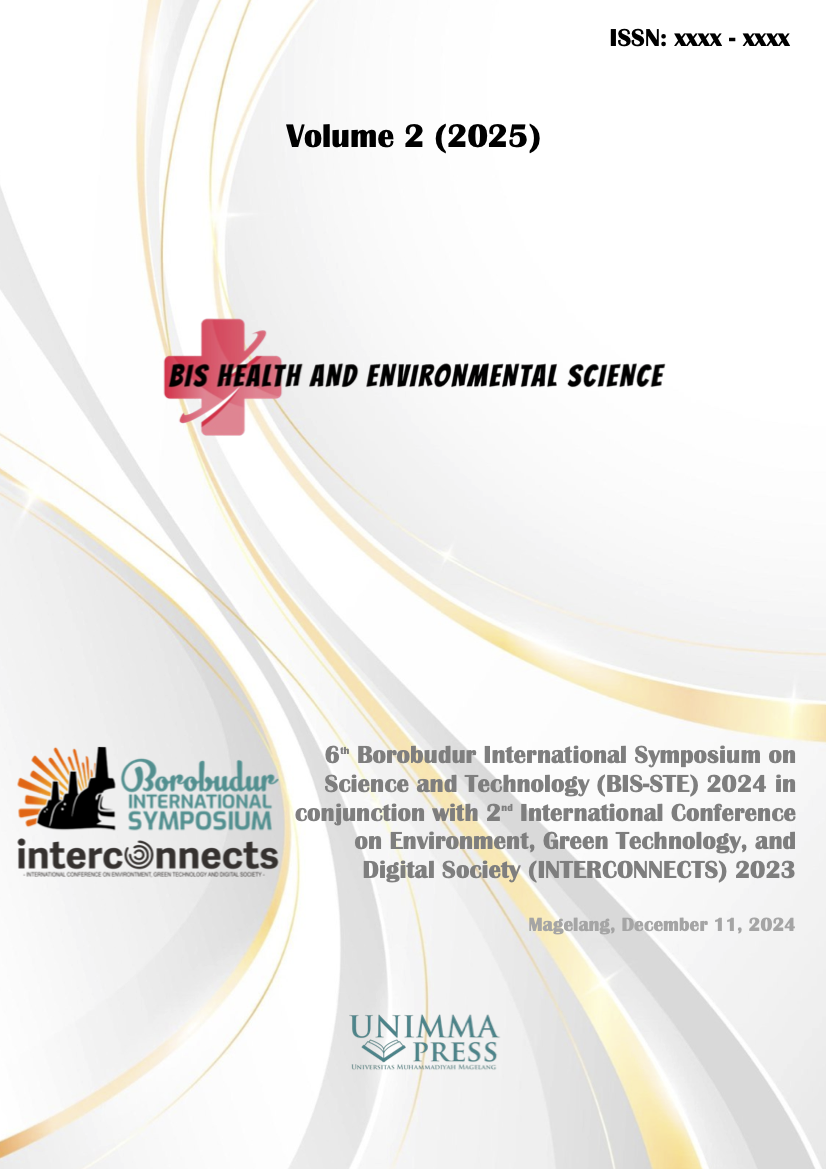Menstrual patterns in women with chronic kidney failure in the hemodialysis room of RSUD Tidar Magelang City
Keywords:
Chronic renal failure, Hemodialysis, Menstrual patternsAbstract
Background: Patients with kidney failure in the final stages will experience a loss of kidney function of up to 90% or more, so that the body’s ability to maintain fluid and electrolyte balance is disrupted, excretory function becomes inadequate, hormonal function is disrupted and the condition of uremia or azotemia occurs. Patients who undergo hemodialysis will cause their menstrual cycle to decrease and stop and even their reproductive function will decrease. Because women who suffer from chronic kidney failure for a long time in their bodies will experience an increase in endocrine, prolactin, leptin. These three elements are involved in reducing the secretion of Gonadotropin-releasing hormone (GnRH) in the hypothalamus, which results in estrogen not being able to stimulate Follicle Stimulating Hormone (FSH) and Luteinizing hormone (LH) so that there is no increase in the corpus luteum which will result in changes in pattern. menstruation. Objective: to determine menstrual patterns in women suffering from chronic kidney failure in the hemodialysis room at Tidar Regional Hospital, Magelang City. Method: The research design used was descriptive quantitative with a cross-sectional design involving 27 respondents. Results: 20 respondents (72%) experienced menstrual cycle disorders, 14 respondents (51.9%) experienced oligomenorrhea, 15 respondents (55.15%) experienced hypomenorrhea and almost all patients experienced cycle changes at the beginning of undergoing hemodialysis, 23 respondents (85%). Conclusion: Some respondents experienced changes in menstrual patterns both according to their menstrual cycle and the amount/volume of bleeding.
References
[1] M. Idzharrusman and J. Budiana, “The Relationship Between Family Support and Quality of Life of Chronic Kidney Failure Patients at Sekarwangi Regional Hospital,” Bsi Nurs. J., vol. 10, no. 1, pp. 61–69, 2022.
[2] G. L. Siregar and E. Tambunan, “Gambaran Kualitas Hidup pasien Gagal Ginjal Kronik yang menjalani Hemodialisa di RSA Bandar Lampung,” Nurs. Updat. J. Ilm. Ilmu Keperawatan, vol. 14, no. 2, 2023.
[3] E. Syahputra, E. K. Laoli, J. Alyah, E. Y. B. HSB, E. Y. E. B. Tumorang, and T. Nababan, “Dukungan Keluarga Berhubungan Dengan Kualitas Hidup Pasien Gagal Ginjal Kronik Yang Menjalani Terapi Hemodialisa,” J. Penelit. Perawat Prof., vol. 4, no. 3, pp. 783–800, 2022.
[4] U. Hasanah, N. R. Dewi, L. Ludiana, A. T. Pakarti, and A. Inayati, “Analisis Faktor-Faktor Risiko Terjadinya Penyakit Ginjal Kronik Pada Pasien Hemodialisis,” J. Wacana Kesehat., vol. 8, no. 2, pp. 96–103, 2023.
[5] J. Serret-Montaya et al., “Hyperprolactinemia as a prognostic factor for menstrual disorders in female adolescents with advanced chronic kidney disease,” Pediatr. Nephrol., vol. 35, no. 6, pp. 1041–1049, 2020.
[6] S. Garg, Satyamoorthy, and S. Ramalakshmi, “Menstrual disorders in chronic kidney disease: causes and management,” Int. J. Clin. Obstet. Gynecol., vol. 4, no. 2, pp. 353–358, 2020.
[7] N. Ardiyani, E. Sari Purbaningsih, I. Nurfajriani, P. Nursing Science Study, and S. Mahardika Cirebon, “Relationship between the Duration of Hemodialysis Therapy and Menstrual Changes in Chronic Kidney Failure Patients Undergoing Hemodialysis at Waled Regional Hospital, Cirebon Regency,” Stikes Mahardika J., pp. 1–4, 2019.
[8] D. Y. Prastiwi, D. Salwani, and Saminan, “The relationship between the duration of hemodialysis and the incidence of secondary amenorrhea in patients with chronic kidney failure at dr. Zainoel Abidin Hospital, Banda Aceh and Tgk. Chik Ditiro Hospital, Sigli,” J. Ilm. Mhs. Medisia, vol. 2, no. 1, pp. 5–11, 2017.
[9] N. P. Saragih, T. I. Sianipar, R. W. Naibaho, and S. D. Halawa, “Hubungan antara tingkat kecemasan dengan lamanya hemodialisis pada pasien gagal ginjal kronik (GGK) yang menjalani HD,” J. Penelit. Perawat Prof., vol. 4, no. 3, pp. 891–898, 2022.
[10] E. N. Soe’mah, I. Kusmindarti, and A. Haryanto, “The Relation Of Long Suffering Chronic Kidney Disease (CKD) And Stress With Menstrual Abnormalities In Hemodialysis Unit RSUD Prof. Dr. Soekandar,” Int. J. Nurs. Midwifery Sci., vol. 6, no. 3, pp. 185–194, 2022.
[11] D. Pratiwi I., A. Rudtitasari, A. S. Lestari, Y. Haryanti, R. Amartani, and T. Suryani E., “Relationship of Body Mass Index (BMI) to Menstrual Cycle in Adolescents in Stikara Sintang,” PROTEIN J. Nurs. Midwifery, vol. 2, no. 1, pp. 359–378, 2024.
[12] F. Botutihe, S. Suntin, and N. Hijrah, Physical Activity and Stress Levels with Menstrual Pattern Disorders. CV. Ruang Tentor, 2022.
[13] S. C. MacLeod, W. I. Morse, S. Hirsch, M. G. Tompkins, and G. Jacey, “Oligomenorrhea: A DOUBLE BLIND STUDY OF THE EFFECTS OF PREDNISONE AND PACEBO,” Am. J. Obstet. Gynecol., vol. 89, pp. 642–645, 2023.
[14] N. Novina, R. A. Mulyanusa, and A. S. Yusuf, “Gonadotropin Levels and Underlying Diseases in Adolescents With Secondary Amenorrhea,” Int. J. Women’s Heal., pp. 1397–1404, 2023.
[15] M. Miraturrofiah, “Incidence of Menstrual Disorders Based on Adolescent Nutritional Status,” J. Mother Child Care, vol. 5, no. 3, pp. 31–42, 2020.
[16] S. Nurjanah, S. Sit, M. Kes, and A. R. Pertiwi, “Menstrual Patterns in Women with Chronic Kidney Failure in Roemani Muhammadiyah Hospital Semarang,” 2020.
[17] D. Dian, T. F. A. G. Atmadja, and A. S. Kosnayani, “Hubungan lama hemodialisis dengan nafsu makan dan status gizi pada pasien penyakit ginjal kronis,” J. SAGO Gizi dan Kesehat., vol. 5, no. 1, pp. 37–43, 2023.
[18] M. Rathi and R. Ramachandran, “Sexual and gonadal dysfunction in chronic kidney disease: Pathophysiology,” Indian J. Endocrinol. Metab., vol. 16, no. 2, pp. 214–219, 2012.
[19] D. Astuti and U. Kulsum, “Menstrual Patterns and the Occurrence of Anemia in Adolescent Girls,” J. Nurs. Midwifery, vol. 11, no. 2, 2020.
Downloads
Published
Conference Proceedings Volume
Section
License

This work is licensed under a Creative Commons Attribution-NonCommercial 4.0 International License.

